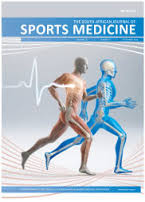The core of performance in adolescent cricket pace bowlers: Trunk muscle stability, maybe, but not strength-endurance and thickness
DOI:
https://doi.org/10.17159/2078-516X/2022/v34i1a12521Abstract
Background: The trunk connects the upper and lower limbs and transfers energy during movement. Exploring the role of the trunk muscles in bowling performance affords us the opportunity to uncover potential mechanisms to improve bowling performance.
Objectives: To investigate the association between bowling performance and trunk muscle stability, strength-endurance and thickness in adolescent pace bowlers.
Methods: Adolescent pace bowlers participated in this crosssectional study. Trunk muscle stability was measured using Sahrmann’s Stability Scale, strength-endurance using the Bourbon Trunk Muscle Strength Test and thickness of the abdominal wall and lumbar multifidus muscles using ultrasound imaging.
Results: Forty-six pace bowlers with a mean age of 15.9 ±1.2 years participated. The average ball release speed was
109.2±11.8 km.h-1 . This measurement was higher in level four of stability than in level two (mean difference 22.2 ± SD 6.8 km.h-1; p= .018). No link between ball release speed and strength-endurance could be found. Multiple correlations of moderate strength (r > 0.4) exist between ball release speed and absolute trunk muscle thickness with height and weight as confounding factors. The relationship between accuracy and the trunk muscle variables investigated in this study is weak.
Conclusion: Bowlers with better trunk muscle stability bowled faster than those with a lower level of trunk stability,
irrespective of their age, height and weight. Trunk muscle thickness correlated with ball release speed; however,
confounding factors such as height and weight play a role and therefore, findings need to be interpreted with caution.
Downloads
Downloads
Additional Files
Published
Issue
Section
License
Copyright (c) 2022 South African Journal of Sports Medicine

This work is licensed under a Creative Commons Attribution 4.0 International License.
The South African Journal of Sports Medicine reserves copyright of the material published. The work is licensed under a Creative Commons Attribution 4.0 (CC BY 4.0) International License. Material submitted for publication in the South African Journal of Sports Medicine is accepted provided it has not been published elsewhere. The South African Journal of Sports Medicine does not hold itself responsible for statements made by the authors.
How to Cite
- Abstract 777
- PDF 599
- PDF (Supplementary) 79






.png)